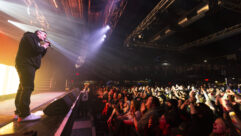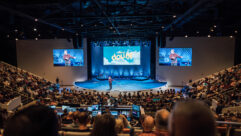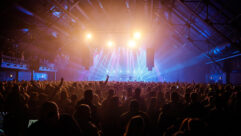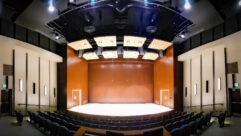On the SVC Podcast, Contributing Editor Bennett Liles completes his conversation with Doug Hood of Custom Sound Designs regarding their complete re-design and installation of a versatile Danley speaker-based sound system for the First Missionary Church in Berne, Indiana. Doug describes how they set up the AV system for quick changes between contemporary and more traditional events including changes in sound, video and lighting.
Links of Interest:
· ProPresenter from Renewed Vision
· Digital Projection 8000-lumen E-Vision Laser 8500 projector
· Black Magic ATEM 2M/E Production Studio 4K
· Panasonic AJ-PX270 Camcorder
· Dot2 XL-F MA Lighting Controller
This is the SVC Podcast from Sound & Video Contractor Magazine with Doug Hood of Custom Sound Designs. Show notes and product links for this one and other SVC podcasts are at svconline.com. At the top of the page go to Podcasts.
A lot of churches are trying to hold on to their traditional congregation while attracting younger members. Such was the case at First Missionary Church in Berne, Indiana. Custom Sound Designs of Fort Wayne came in with new sound, lighting and video all on presets. CSD’s Doug Hood is back to finish the story on how they got it all done. That’s right here on the SVC Podcast.
Doug, good to have you back with us this week from Custom Sound Designs in Ft. Wayne, Indiana. You renovated the sound, video and lighting for the First Missionary Church. They have a younger generation coming in with their events and at the same time a more traditional congregation. They want to be able to change the whole atmosphere from one to the other with the AV system. Is that a fairly typical situation in growing churches?
Yeah, it definitely is. We get a lot of phone calls like this particular project where we have the fundamental belief that if you’re going to do something, do it to excellence. So if that means you are a traditional church, then that’s great. Identify with that and you’re traditional and do that as best as you can. And if you’re completely on the other end of the spectrum and your temporary production, concert – the complete opposite of traditional whatever that is [Laughs], if you’re on that end of the spectrum then great. Do that with excellence – and everything in between. We do find a lot of churches that have historically been maybe either traditional or more light contemporary and they’re trying to reach a different demographic, a different generation. But they want to do that and they need to do that in the same space and sometimes they need to do it in the same space and they’ve only got maybe 15 minutes between services. So how do you hold on, for example, if your 9:00 service is traditional and you’ve got organ and piano, how do you still do that and reach those traditional people and not rock the boat there? But then let’s say at 10:30 you’ve got a second service and you want that to be different. You want that to be more visually creative. You want a band to come in and instead of piano and organ now it’s a worship leader and a praise team and drums and electric guitar and acoustic guitar and keyboards and all that stuff. So how do you do that in that same space without having major amounts of work and major amounts of moving things around? How can you do that? And so for us, in our business, a lot of how you do that is with the visual side of it. Both of those scenarios need a good sound system, which we talked about last week. So you’re going to have that no matter what. You’re going to have to have a speaker system and console and mics and everything that allow you to communicate spoken word and music at a high level. So both of those scenarios have that in common, but where they’re different is the visual side of it. And so what we see is that by using things such as creative lighting and immersive video, environmental projection, architectural accent lighting, all these visual things, these are things that we can design and install and they can be in the room and they can be almost hidden where nobody at the 9:00 traditional service is really even aware that they are there – or if they’re there they’re not turned on and they’re not really bothering anybody. But then when traditional service dismisses and you’ve got the next round of people that come in, you can flip a switch and have that room be just wildly different than it was just a few minutes ago. And so for these churches that are trying to bridge that gap and they’re trying to do something different without having to haul out different staging and props and scenery and just all the physical things, we’re able to take a room and really transform it with a lot of digital things or presets that don’t require a lot of time and physical labor to move between the services. So yeah, we’ve seen that be a really important thing to a lot of churches that are trying to make that transition. [Timestamp: 4:29]
And it probably helps when you have a steady crew there, even if they’re all volunteers, that are used to doing this and it’s kind of routine. A few settings on the mixer, a few presets on the lighting and they can change it up without a lot of physical stuff to drag around and rearrange.
Yeah. All of that in the world of audio and lighting, what you said is correct. So you can spend a lot of time on the front end or the design portion of it and create all these different settings, which that takes time. It takes time both in the audio realm and also in video and lighting. But the great thing is once you’re done you just save it as a snapshot. So when that second service comes in you hit a button and everything is reconfigured for the band that is totally different than it was when it was organ and piano. And you hit a button on the lighting console and all those lights that maybe were not used in the first service or maybe there were just white lights in the first service, now they can be full color. Now they can be lights that are physically moving to different positions on the stage. Sometimes we’ll have a large center screen in the back or an LED wall. Both of those things can be used as digital scenery so you really have, again back to the canvas scenario, you really have this big piece of canvas that you can paint on and do whatever you need to for whatever kind of service you’re having. [Timestamp: 5:53]
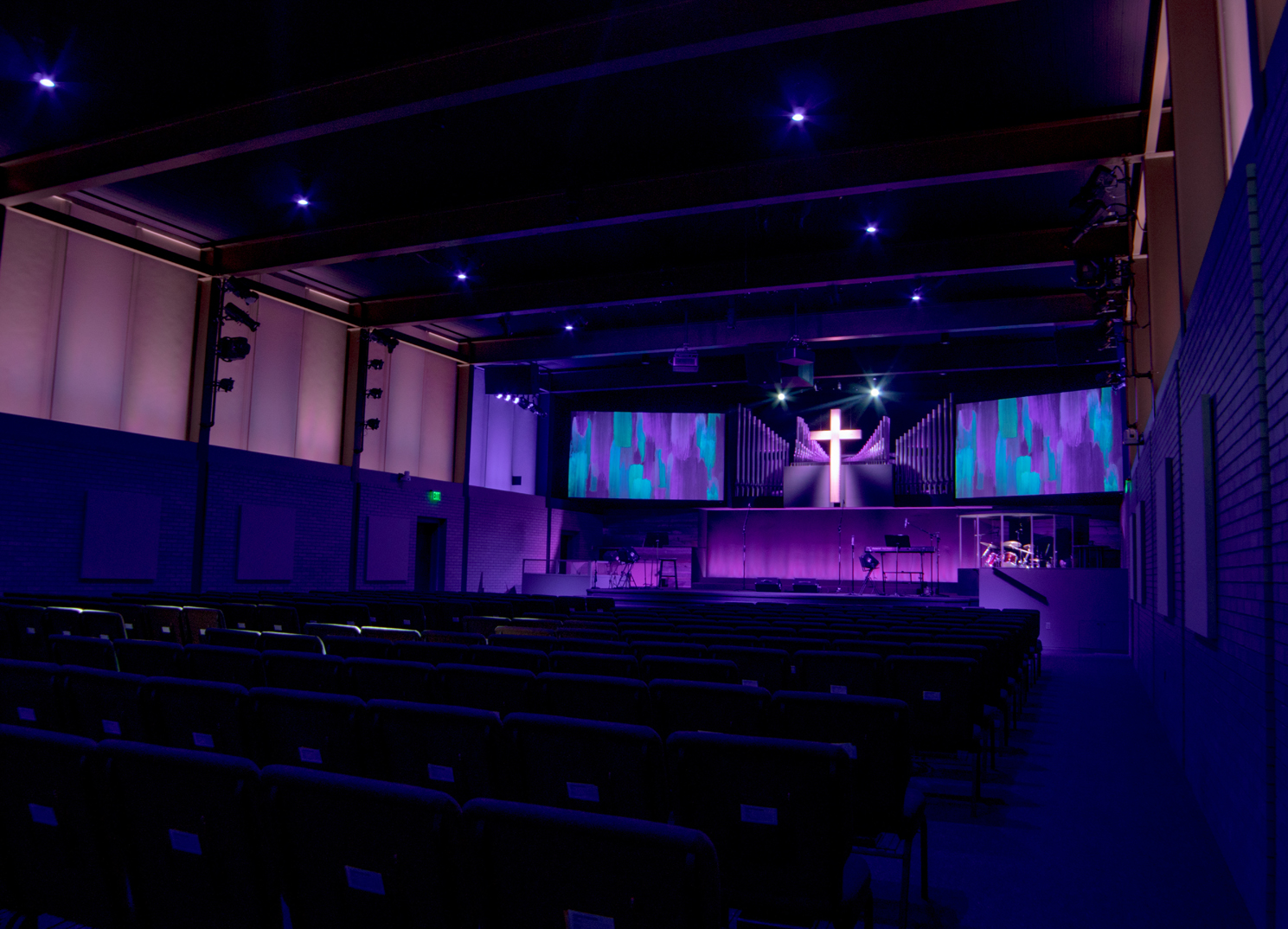
Do they control all of this, the sound, lighting and video from the front in the same spot or is it set up for control from different places?
In this case they’re both on the ground in the back. We have sound and lighting in the main booth and then broadcast is right behind that. So broadcast has your video switching and camera equipment behind that. So that’s a pretty common scenario depending on the room. Sometimes you’ll see a separate suite that has a broadcast and a video and the camera equipment off in a separate room. That works well too. But in this particular install you’ve got sound and lighting in the main control booth and then you have video and cameras directly behind them. [Timestamp: 6:38]
And how old is this building? It must have been somewhat of a challenge. You had to at least set up some rigging for the speakers.
Yeah, definitely. If I had to guess, I think it’s probably in the 50’s – you know, somewhere in that realm. There’s different parts that are older than others. But yeah, rigging was interesting. The amp room is actually backstage and beneath the stage in a basement so we had to use some of those existing pathways, some of the existing power that was there. But all in all, I mean considering the age of it, it wasn’t as challenging as we thought it might have been going into it. [Timestamp: 7:11]
And we know this is a very long, deep house and they have a balcony at the back end of it?
Yes, they do.
And I think we mentioned before that there was an extra speaker installation to cover that balcony area.
Yeah, like we talked about last week we have the three main speakers in the front of the room and then we also have three delayed speakers for the balcony. And the cool thing about this design is we’re able to run a true left-center-right for all those seats so wherever you’re at you can have an LCR experience; whether you’re on the floor or the balcony. [Timestamp: 7:41]
That was a lot to do. How long did it take you to run and rig everything, get the amps, video and lighting all set up on this? Did you have to get in between services or did they have another location they were using while all of this installation was going on?
Yeah, the nice thing about this project was they did have a multipurpose room on campus. And so besides all the things they were doing with AV, they actually did new flooring, they did new seating. And so the sanctuary was tore up pretty good. So they were out of there for several weeks and then they gathered to worship in the multipurpose room. So for us and our crew, that was great. Our duration of install from start to finish was about four weeks’ total [Timestamp: 8:24]
Well, that wasn’t too bad with them using another location and you’re not having to start and stop all the way through it. That would have been pretty tough. So what other projects have you got happening for Custom Sound Designs?
We’ve got all kinds of stuff. We’ve got some international projects that are in the works. And here in our office, since we just moved back in August, we’ve got a world’s first immersive audio experience that we’re building in here at our office that we’ll be able to take objects and map them in real time across the stage, and also experience active acoustics. So that’s probably the coolest thing that’s going on right now, but there’s always some wild stuff happening at our company for sure.
Good to have plenty of work. Doug Hood with Custom Sound Designs in Fort Wayne and First Missionary Church with brand new sound, video and lighting to get members of all ages in tune with any event. Thanks for telling us about it, Doug.
Yeah, thanks for the opportunity. I appreciate it.
Congratulations to First Missionary Church and Custom Sound Designs for a job well done. Now they can set the sound, video and lighting scene for any group and any event. Get back with us for more stories on successful AV system installation on the next SVC Podcast.


